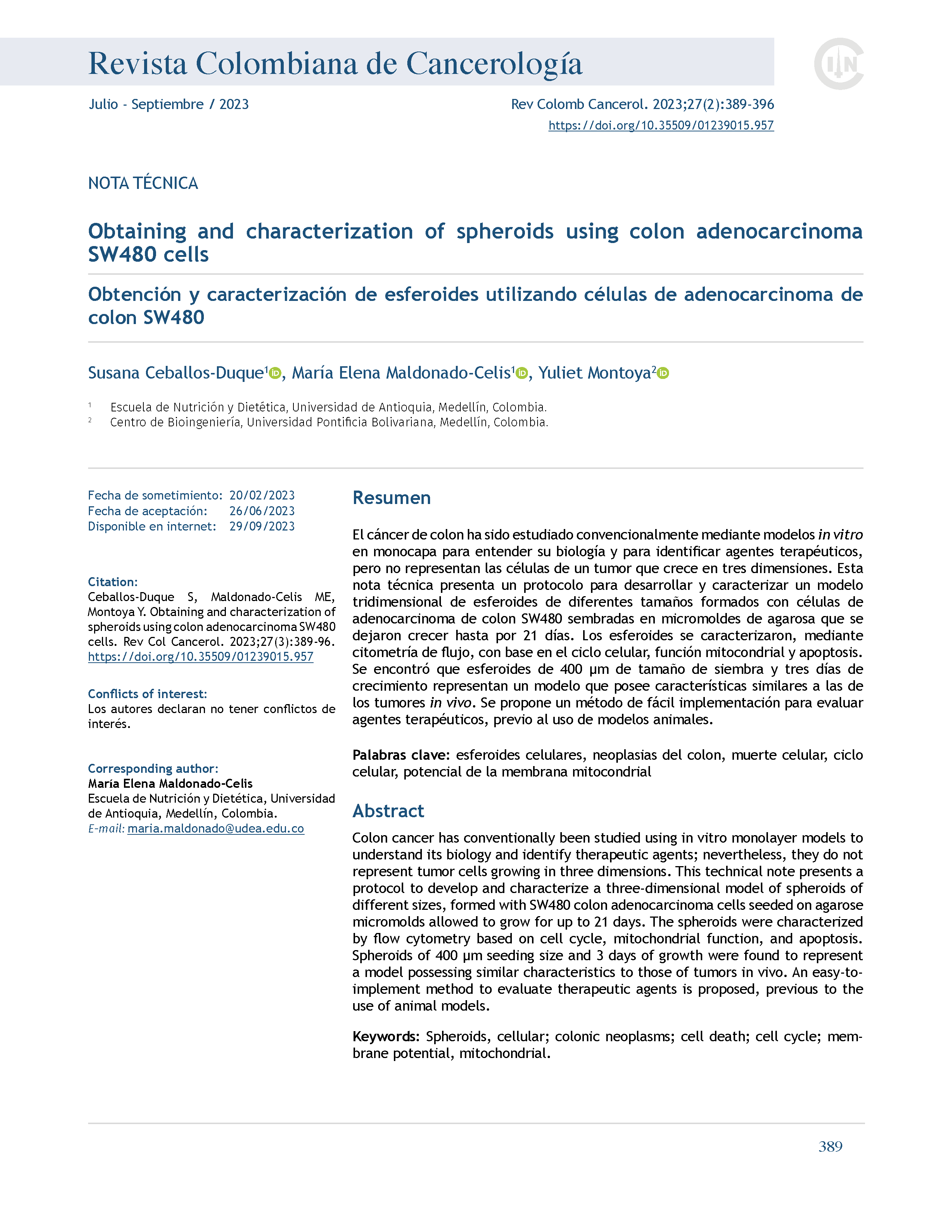Obtaining and characterization of spheroids using colon adenocarcinoma SW480 cells
DOI:
https://doi.org/10.35509/01239015.957Keywords:
Spheroids, cellular, colonic neoplasms, cell death, cell cycle, membrane potential, mitochondrialAbstract
Colon cancer has conventionally been studied using in vitro monolayer models to understand its biology and identify therapeutic agents; nevertheless, they do not represent tumor cells growing in three dimensions. This technical note presents a protocol to develop and characterize a three-dimensional model of spheroids of different sizes, formed with SW480 colon adenocarcinoma cells seeded on agarose micromolds allowed to grow for up to 21 days. The spheroids were characterized by flow cytometry based on cell cycle, mitochondrial function, and apoptosis. Spheroids of 400 µm seeding size and 3 days of growth were found to represent a model possessing similar characteristics to those of tumors in vivo. An easy-to-implement method to evaluate therapeutic agents is proposed, previous to the use of animal models.
Author Biographies
Susana Ceballos-Duque, Escuela de Nutrición y Dietética, Universidad de Antioquia, Medellín, Colombia.
1. Escuela de Nutrición y Dietética, Universidad de Antioquia, Medellín, Colombia.
María Elena Maldonado-Celis, Escuela de Nutrición y Dietética, Universidad de Antioquia, Medellín, Colombia.
1. Escuela de Nutrición y Dietética, Universidad de Antioquia, Medellín, Colombia.
Yuliet Montoya, Centro de Bioingeniería, Universidad Pontificia Bolivariana, Medellín, Colombia.
2. Centro de Bioingeniería, Universidad Pontificia Bolivariana, Medellín, Colombia.
References
Sung H, Ferlay J, Siegel RL, Laversanne M, Soerjomataram I, Jemal A, et al. Global Cancer Statistics 2020: GLOBOCAN estimates of incidence and mortality worldwide for 36 cancers in 185 countries. CA Cancer J Clin. 2021;71(3):209-49. https://doi.org/10.3322/caac.21660
Mazzoleni G, Di Lorenzo D, Steimberg N. Modelling tissues in 3D: the next future of pharmaco-toxicology and food research? Genes Nutr. 2009;4(1):13-22. https://doi.org/10.1007/s12263-008-0107-0
Imamura Y, Mukohara T, Shimono Y, Funakoshi Y, Chayahara N, Toyoda M, et al. Comparison of 2D- and 3D-culture models as drug-testing platforms in breast cancer. Oncol Rep. 2015;33(4):1837-43. https://doi.org/10.3892/or.2015.3767
Lovitt CJ, Shelper TB, Avery VM. Advanced cell culture techniques for cancer drug discovery. Biology. 2014;3(2):345-67. https://doi.org/10.3390/biology3020345
Breslin S, O’Driscoll L. Three-dimensional cell culture: the missing link in drug discovery. Drug Discov Today. 2013;18(5-6):240-9. https://doi.org/10.1016/j.drudis.2012.10.003
Kapałczyńska M, Kolenda T, Przybyla W, Zajaczkowska M, Teresiak A, Filas V, et al. 2D and 3D cell cultures – a comparison of different types of cancer cell cultures. Arch Med Sci. 2018;14(4):910-9. https://doi.org/10.5114/aoms.2016.63743
Ravi M, Paramesh V, Kaviya SR, Anuradha E, Paul Solomon FD. 3D cell culture systems: advantages and applications. J Cell Physiol. 2015;230(1):16-26. https://doi.org/10.1002/jcp.24683
Virgone-Carlotta A, Lemasson M, Mertani HC, Diaz J-J, Monnier S, Dehoux T, et al. In-depth phenotypic characterization of multicellular tumor spheroids: Effects of 5-fluorouracil. PLoS One. 2017;12(11):e0188100. https://doi.org/10.1371/journal.pone.0188100
Moreno-Londoño AP, Castañeda-Patlán MC, Sarabia-Sánchez MA, Macías-Silva M, Robles-Flores M. Canonical Wnt pathway is involved in chemoresistance and cell cycle arrest induction in colon cancer cell line spheroids. Int J Mol Sci. 2023;24(6):5252. https://doi.org/10.3390/ijms24065252
Tomita N, Jiang W, Hibshoosh H, Warburton D, Kahn SM, Weinstein IB. Isolation and characterization of a highly malignant variant of the SW480 human colon cancer cell line. Cancer Res. 1992;52(24):6840-7. PMID: 1458472
Pognan F, Beilmann M, Boonen HCM, Czich A, Dear G, Hewitt P, et al. The evolving role of investigative toxicology in the pharmaceutical industry. Nat Rev Drug Discov. 2023;22(4):317-35. https://doi.org/10.1038/s41573-022-00633-x
Baião A, Dias S, Soares AF, Pereira CL, Oliveira C, Sarmento B. Advances in the use of 3D colorectal cancer models for novel drug discovery. Expert Opin Drug Discov. 2022;17(6):569-80. https://doi.org/10.1080/17460441.2022.2056162
Hewitt RE, McMarlin A, Kleiner D, Wersto R, Martin P, Tsokos M, et al. Validation of a model of colon cancer progression. J Pathol. 2000;192(4):446-54. https://doi.org/10.1002/1096-9896(2000)9999:9999%3C::aid-path775%3E3.0.co;2-k
Maldonado ME, Bousserouel S, Gossé F, Minker C, Lobstein A, Raul F. Differential induction of apoptosis by apple procyanidins in TRAIL-sensitive human colon tumor cells and derived TRAIL-resistant metastatic cells. J Cancer Mol. 2009;5(1):21-30. Available from: https://bibliotecadigital.udea.edu.co/bitstream/10495/21982/3/MaldonadoMaria_2009_DifferentialInductionApoptosis.pdf
Ramirez V, Arango SS, Maldonado ME, Uribe D, Aguillón JA, Quintero JP, et al. Biological activity of Passiflora edulis f. flavicarpa ethanolic leaves extract on human colonic adenocarcinoma cells. J Appl Pharm Sci. 2019;9(02):64-71. Available from: http://hdl.handle.net/20.500.12622/3232
Cottet-Rousselle C, Ronot X, Leverve X, Mayol JF. Cytometric assessment of mitochondria using fluorescent probes. Cytometry A. 2011;79(6):405-25. https://doi.org/10.1002/cyto.a.21061
Crowley LC, Marfell BJ, Scott AP, Waterhouse NJ. Quantitation of apoptosis and necrosis by annexin V binding, propidium iodide uptake, and flow cytometry. Cold Spring Harb Protoc. 2016;2016(11):953-7. https://doi.org/10.1101/pdb.prot087288
How to Cite
Downloads

Downloads
Published
Issue
Section
License
Copyright (c) 2023 Revista Colombiana de Cancerología

This work is licensed under a Creative Commons Attribution-NonCommercial-NoDerivatives 4.0 International License.
Todos los derechos reservados.
Funding data
-
Departamento Administrativo de Ciencia, Tecnología e Innovación (COLCIENCIAS)
Grant numbers FP44842-211-2018 -
Universidad de Antioquia
Grant numbers 2020-2021

| Article metrics | |
|---|---|
| Abstract views | |
| Galley vies | |
| PDF Views | |
| HTML views | |
| Other views | |



